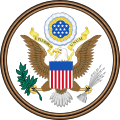- New Jersey state historical coat of arms (illustrated, 1876)
| Coat of arms of the State of New Jersey | |
|---|---|
 | |
| Versions | |
 Great Seal of the State of New Jersey | |
| Armiger | State of New Jersey |
| Adopted | 1777 (modified 1928) |
| Crest | Upon a helm Or, a horse's head cabossed proper. |
| Torse | Argent and azure, the mantling azure doubled argent. |
| Shield | Azure; per pale three ploughs proper. |
| Supporters | In dexter the goddess Liberty affronté carrying in her dexter hand a pole, proper, surmounted by a cap gules, with band azure at the bottom, displaying on the band six stars, argent; in sinister the goddess Ceres affronté bearing a cornucopia Or bearing apples, grapes, and plums proper |
| Motto | Liberty and Prosperity |
| Designer | Pierre Eugene du Simitiere |
 | |
| Use | State flag |
|---|---|
| Proportion | 3:5 |
| Adopted | May 11, 1896 |
| Design | The state coat of arms centered on a buff colored field. |
The coat of arms of New Jersey was adopted in 1777 and modified in 1928. It depicts a shield with three plows flanked by two women. Above the shield is a horse's head atop a knight's helmet. Below everything is a banner that reads Liberty and Prosperity 1776. The state seal of New Jersey depicts the coat of arms on a white disc surrounded by the state name. The flag of New Jersey was adopted on May 11, 1896. It features the coat of arms on a buff field.




















